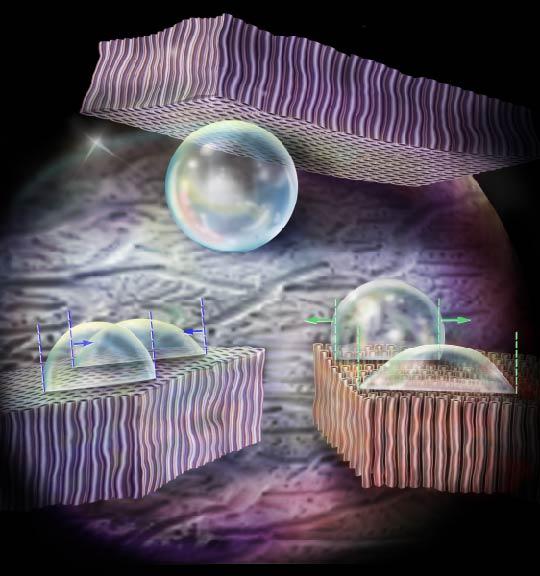New Pitt research finds carbon nanotubes show a love/hate relationship with water

An illustration shows the wetting behavior of carbon nanotubes, which both repel water and hold it in place. Credit: University of Pittsburgh
New research reveals even more potential for CNTs: as a coating, they can both repel and hold water in place, a useful property for applications like printing, spectroscopy, water transport, or harvesting surfaces.
When water is dropped on a CNT forest, the CNTs repel the water, and it forms a sphere. However, when flipped over, the drop does not fall to the ground but rather clings to the surface.
“In contrast to superhydrophobic surfaces where droplets roll off easily when tilted, CNTs forests are parahydrophobic, where the droplet is both repelled and attracted to the CNT surface,” explains Ziyu Zhou, lead author of the paper and graduate student in the LAMP Lab. “It is a love-hate relationship.”
The key to this wetting behavior is the use of CNT forests that are densely, vertically packed on the surface and the inherently hydrophilic CNT surface.
The forests are about 100 microns in height and so dense that there are over 100 billion (1011) CNTs in 1 cm2 area. Some amount of water sinks below the carbon nanotubes and clings to the hydrophilic material, while the rest is repelled into a sphere.
This research represents the first observation of parahydrophobicity of CNT forests, where the droplet can roll along the surface but does not fall off when turned upside down.
Other surfaces in nature such as peach fuzz or rose petals also exhibit this wetting behavior, which may be used to for liquid transportation, fabrics coating design, membrane selectivity and even wall-climbing robotics.
This wetting behavior could also be used to as a way to construct CNTs into various arrangements.
“Previous research showed CNT forests to be unstable under the application of water, but we show that water droplets are, in fact, stable on these dense CNT forests,” explains Paul Leu, PhD, associate professor of industrial engineering at the University of Pittsburgh's Swanson School of Engineering and author on the paper.
“This wetting behavior may be used to assemble CNTs into dense vertical arrays, surface stripes, and other unique shapes that could be used for supercapacitors, interconnects, and other applications.”
###
Leu also has appointments in chemical engineering and mechanical engineering and material science. His lab, the Laboratory for Advanced Materials at Pittsburgh (LAMP), conducted the research.
The paper, “Parahydrophobicity and stick-slip wetting dynamics of vertically aligned carbon nanotube forests,” (DOI: 10.1016/j.carbon.2019.06.012) was published in the journal Carbon and was coauthored by Ziyu Zhou, Tongchuan Gao, Sean McCarthy, Andrew Kozbial, Susheng Tan, David Pekker, Lei Li, and Paul W. Leu.
Media Contact
All latest news from the category: Materials Sciences
Materials management deals with the research, development, manufacturing and processing of raw and industrial materials. Key aspects here are biological and medical issues, which play an increasingly important role in this field.
innovations-report offers in-depth articles related to the development and application of materials and the structure and properties of new materials.
Newest articles

“Nanostitches” enable lighter and tougher composite materials
In research that may lead to next-generation airplanes and spacecraft, MIT engineers used carbon nanotubes to prevent cracking in multilayered composites. To save on fuel and reduce aircraft emissions, engineers…

Trash to treasure
Researchers turn metal waste into catalyst for hydrogen. Scientists have found a way to transform metal waste into a highly efficient catalyst to make hydrogen from water, a discovery that…

Real-time detection of infectious disease viruses
… by searching for molecular fingerprinting. A research team consisting of Professor Kyoung-Duck Park and Taeyoung Moon and Huitae Joo, PhD candidates, from the Department of Physics at Pohang University…





















